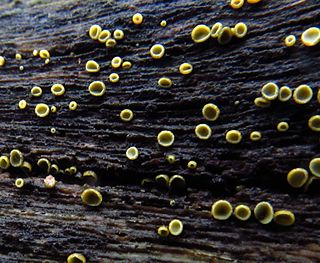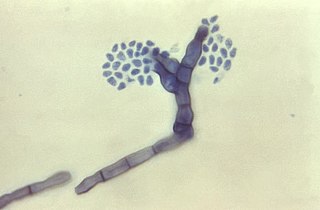
Amanita porphyria, also known as the grey veiled amanita or the porphyry amanita, is a fairly common, inedible mushroom of the genus Amanita found in Europe and North America.

Trichoderma is a genus of fungi in the family Hypocreaceae that is present in all soils, where they are the most prevalent culturable fungi. Many species in this genus can be characterized as opportunistic avirulent plant symbionts. This refers to the ability of several Trichoderma species to form mutualistic endophytic relationships with several plant species. The genomes of several Trichoderma specieshave been sequenced and are publicly available from the JGI.

Trichophyton is a genus of fungi, which includes the parasitic varieties that cause tinea, including athlete's foot, ringworm, jock itch, and similar infections of the nail, beard, skin and scalp. Trichophyton fungi are molds characterized by the development of both smooth-walled macro- and microconidia. Macroconidia are mostly borne laterally directly on the hyphae or on short pedicels, and are thin- or thick-walled, clavate to fusiform, and range from 4 to 8 by 8 to 50 μm in size. Macroconidia are few or absent in many species. Microconidia are spherical, pyriform to clavate or of irregular shape, and range from 2 to 3 by 2 to 4 μm in size.

Chlorosplenium is a genus of fungi in the family Dermateaceae. The genus was circumscribed by Elias Magnus Fries in 1849.
Cashiella is a genus of fungi in the family Dermateaceae. The genus contains four species. Cashiella, circumscribed in 1951 by Franz Petrak, is named in honor of American mycologist Edith Katherine Cash.
Duebenia is a genus of fungi in the family Dermateaceae. The genus contains 2 species.
Dennisiodiscus is a genus of fungi in the family Dermateaceae. The genus contains 10 species.

Neofabraea is a genus of fungi in the family Dermateaceae. The genus contains 12 species.
Neotapesia is a genus of fungi in the family Dermateaceae. The genus contains 3 species.
Sorokina is a genus of fungi in the family Dermateaceae. The genus contains 6 species.
Sorokinella is a genus of fungi in the family Dermateaceae. The genus contains 2 species.
Schizothyrioma is a genus of fungi in the family Dermateaceae. The genus contains 2 species.
Pyrenopeziza is a genus of fungi in the family Dermateaceae. The genus contains 59 species.

Thelebolus is a genus of fungi in the Thelebolaceae family. Often considered related to Pezizales, 18S phylogenies show Thelebolales are a sister group to Pseudeurotiaceae and Leotiales. ITS is an adequate DNA barcode but there are only six variable sites in Thelebolus; β-tubulin is a recommended secondary barcode.

Mycena arcangeliana is a species of Mycenaceae fungus. It has been known by a number of scientific names, and its taxonomy is still somewhat disputed. It produces small mushrooms with caps varying in colour from whitish to a darker grey-brown, and stems of an olive-greyish that fade with age. The mushrooms can be mistaken for the similar Mycena flavescens. They have a mild taste, but a strong smell of iodoform; they are not edible. The species grows on dead wood in autumn months, and can be found throughout Europe.

Fonsecaea compacta is a saprophytic fungal species found in the family Herpotrichiellaceae. It is a rare etiological agent of chromoblastomycosis, with low rates of correspondence observed from reports. The main active components of F. compacta are glycolipids, yet very little is known about its composition. F. compacta is widely regarded as a dysplastic variety of Fonsecaea pedrosoi, its morphological precursor. The genus Fonsecaea presently contains two species, F. pedrosoi and F. compacta. Over 100 strains of F. pedrosoi have been isolated but only two of F. compacta.

Aspergillus clavatus is a species of fungus in the genus Aspergillus with conidia dimensions 3–4.5 x 2.5–4.5 μm. It is found in soil and animal manure. The fungus was first described scientifically in 1834 by the French mycologist John Baptiste Henri Joseph Desmazières.
Skeletocutis azorica is a species of poroid fungus in the family Polyporaceae. It has only been found in Portugal.

Penicillium spinulosum is a non-branched, fast-growing fungus with a swelling at the terminal of the stipe (vesiculate) in the genus Penicillium. P. spinulosum is able to grow and reproduce in environment with low temperature and low water availability, and is known to be acidotolerant. P. spinulosum is ubiquitously distributed, and can often be isolated from soil. Each individual strain of P. spinulosum differs from others in their colony morphology, including colony texture, amount of sporulation and roughness of conidia and conidiophores.

Mariannaea elegans an anamorphic fungus. It is mainly found on rotting wood and soil. M. elegans is not pathogenic to humans, animals, or plants.











